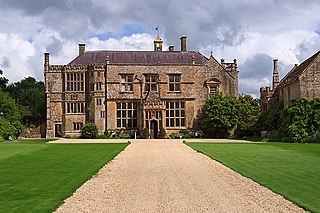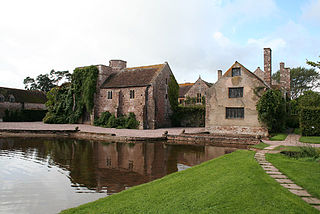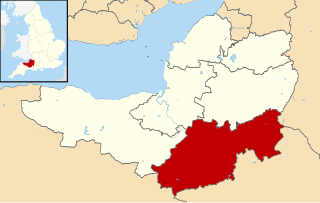
The Quantock Hills west of Bridgwater in Somerset, England, consist of heathland, oak woodlands, ancient parklands and agricultural land. They were England's first Area of Outstanding Natural Beauty, designated in 1956.

Glastonbury Abbey was a monastery in Glastonbury, Somerset, England. Its ruins, a grade I listed building and scheduled ancient monument, are open as a visitor attraction.

Bath Spa University is a public university in Bath, England, with its main campus at Newton Park, about 3+1⁄2 miles (5.6 km) west of the centre of the city. The university has other campuses in the city of Bath, and one at Corsham Court in Wiltshire.

Ashton Court is a mansion house and estate to the west of Bristol in England. Although the estate lies mainly in North Somerset, it is owned by the City of Bristol. The mansion and stables are a Grade I listed building. Other structures on the estate are also listed.

Chicheley Hall, Chicheley, Buckinghamshire, England is a country house built in the first quarter of the 18th century. The client was Sir John Chester, the main architect was Francis Smith of Warwick and the architectural style is Baroque. Later owners included David Beatty, 2nd Earl Beatty and the Royal Society. Chicheley Hall is a Grade I listed building.

Brympton is a village, civil parish and electoral ward in Somerset, England. The parish is situated on the north-west edge of Yeovil. The parish/ward has a population of 7,308. The civil parish covers the western part of the Yeovil built up area, including the stadium of Yeovil Town F.C. at Huish Park, and also includes the hamlets of Brympton D'Evercy, Lufton, Thorne Coffin and Alvington as well as part of Chilthorne Domer. From 1974 to 2023 it was in South Somerset district.

Brympton d'Evercy, a grade I listed manor house near Yeovil in the county of Somerset, England, has been called the most beautiful in England. In 1927 the British magazine Country Life devoted three articles to it, in which Christopher Hussey, near the start of a 50-year career as an architectural authority, termed it "the one which created the greatest impression and summarises so exquisitely English country life qualities." His articles remain the only detailed account of the house, which has belonged to six families: the D'Evercys, Stourtons, Sydenhams, Fanes, Weeks (1992–2008), and Glossops.

East Harptree is a village and civil parish in Somerset, England. It is situated 5 miles (8.0 km) north of Wells and 15 miles (24.1 km) south of Bristol, on the northern slope of the Mendip Hills overlooking the Chew Valley. The parish has a population of 644. The parish includes the hamlet of Coley.

Crowcombe is a village and civil parish under the Quantock Hills in Somerset, England, 5.5 miles (9 km) southeast of Watchet, and 8 miles (13 km) from Taunton. The village has a population of 489.

Stokesay Court is a country house and estate in the parish of Onibury in Shropshire, England. Described by John Newman, in the Shropshire volume of Pevsner's Buildings of England, as "the most grandiloquent Victorian mansion in the county", Stokesay is a Grade II* listed building.

The Grade I listed buildings in Somerset, England, demonstrate the history and diversity of its architecture. The ceremonial county of Somerset consists of a non-metropolitan county, administered by Somerset County Council, which is divided into five districts, and two unitary authorities. The districts of Somerset are West Somerset, South Somerset, Taunton Deane, Mendip and Sedgemoor. The two administratively independent unitary authorities, which were established on 1 April 1996 following the breakup of the county of Avon, are North Somerset and Bath and North East Somerset. These unitary authorities include areas that were once part of Somerset before the creation of Avon in 1974.

Cothay Manor is a grade one listed medieval house and gardens, in Stawley, near Wellington, Somerset. The manor grounds consist of almost 40 acres and include cottages, outbuildings, stables, and 12 acres of gardens.

South Somerset is a local government district in the English county of Somerset. The South Somerset district occupies an area of 370 square miles (958 km2), stretching from its borders with Devon and Dorset to the edge of the Somerset Levels. The district has a population of about 158,000, and has Yeovil as its administrative centre.

The Church of the Holy Ghost in Crowcombe, Somerset, England has a tower dating from the 14th century with the rest of the building being dated at the 15th century. It has been designated by Historic England as a Grade I listed building.

Hatch Court in the parish of Hatch Beauchamp, in Somerset, England, is a grade I listed mansion built in about 1755 in the Palladian style with Bath Stone by the wool merchant John Collins to the design of Thomas Prowse. The site had been occupied since the mediaeval era by various forms of the manor house of the manor of Hatch, the caput of an important feudal barony first held by the Anglo-Norman de Beauchamp family in the 11th century.

Tintinhull Court in Tintinhull, Somerset, England, was built as a medieval parsonage for the Church of St Margaret. It has been designated as a Grade I listed building.

The Church of St Andrew in Brympton, Somerset, England, dates from the 13th century and has been designated as a Grade I listed building.
Nathaniel Ireson was a potter, architect and mason best known for his work around Wincanton in Somerset, England.

Camerton Court is a historic house in the village of Camerton, Somerset, England. It has been designated as a Grade II listed building.

Mohuns Ottery or Mohun's Ottery, is a house and historic manor in the parish of Luppitt, 1 mile south-east of the village of Luppitt and 4 miles north-east of Honiton in east Devon, England. From the 14th to the 16th centuries it was a seat of the Carew family. Several manorial court rolls survive at the Somerset Heritage Centre, Taunton, Somerset.



















